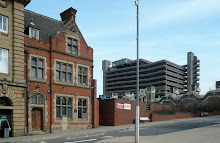| |
| | |
Psychic GeographyEric Bainbridge Sophie Lisa Beresford David Blandy Dan Ford Laura Lancaster Mike Pratt James Richards Daniel Silver Lara Viana23rd January – 20th February 2010 Tues - Sat, 11am -5pm (or by appointment) Preview: Friday 22nd January, 6-9pm “…The psychic geographer specializes in spotting that place where humans and their environment meld and we can no longer speak of individual will as such, but only communal or sometimes corporate imperatives, the desires of the space as it speaks through the body politic that inhabits it” 1 Workplace Gallery is pleased to present Psychic Geography a group exhibition of new and existing works by nine diverse artists. The exhibition includes Collage, Painting, Photography, Sculpture, and Video that examines the interaction between spaces and people, places and identity. In a new series of collages by Eric Bainbridge, base elements taken from interior design and fashion magazines are cleverly disguised through simple manipulation. Eyes, mouths, sinks, stairs are all hidden, replaced with abstracted patterned forms themselves cut from the same source to leave us with hybrid unsettling images that are both familiar and absurd. In The First and Second Creation part of an ongoing series of intimate and revelatory ‘to camera’ videos Sophie Lisa Beresford attempts to communicate her complex and unified world view whilst also exploring with her own problematic and paradoxical relationship to making ‘Art’ and to ‘Being’. David Blandy’s work highlights the slippage and tension between fantasy and reality. In Hollow Bones Blandy performs Syl Johnson’s underground soul classic "Is It Because I’m Black" in an inverted “whiteface” version of the racist stereotype from American theatre of the 19th Century, popularized until 1978 in the BBC Television’s “The Black & White Minstrel Show“. Blandy’s film takes an alternative position: by appropriating the politically ‘correct’ and ‘incorrect’ he finds an antiheroic and morally ambiguous alter-ego that becomes archetypal and symbolic of Blandy’s quest for identity and cultural position. Dan Ford’s paintings and drawings examine the design industry aesthetics found in disparate pockets of visual culture such as knitting patterns, S&M magazines, sauna brochures and comic books. In Sheet 2009 a page of Dildos is the starting point for a small delicate painting in which shapes become merely motifs that expose the quality of the image against the artists sense of placement and appropriation. Laura Lancaster’s new series of 21 portrait paintings deconstruct the photographs they are copied from to such an extent that faces and features are obliterated with painterly gesture. The almost monochrome works leave us guessing as to the period, class, and identity of the subjects. Short Back And Sides (Bombay Bad Boy) is a new sculpture by Mike Pratt in which 12 classic art school plaster busts are reduced to the role of plinth for an assemblage of furniture and found objects. Through a process of re-enacting, borrowing and re-appropriation Pratt comments upon the cycle of assimilation constantly evolving from an affecting voice or act into popular culture. James Richards uses the accumulation and reassembly of imagery as a devotional and elegiac process. In his looped video Misty Boundaries Has Left the Room he entices us with a quick fire sequence of brief vignettes: a puff of steam, a hand being held, soap bubbles, a blizzard, followed by a clip from a television programme about how to draw until a girl zones out in a classroom as the tutorial explains how to realistically depict an eye. Daniel Silver’s sculptural installation Studies for Adam and Eve (1-3) mixes found objects with small sculptures presented in a series of altar like cabinets. Silver’s works play with universal values and tradition presenting us with ambiguous figures that echo religious artifact, iconic sculpture, mutation, and disfigurement. For Lara Viana painting itself is a tool for transport. In her recent paintings we are taken to the tabletop aftermath of opulent dinner parties. The fluid marks symbolise an experience of these forms and subjects, dreamlike in their foggy depictions, and at the same time, as substantially real as the memory of a past experience. To celebrate the opening of Psychic Geography there is an Afterparty at the BALTIC Centre for Contemporary Art from 9pm onwards, with special guest DJ's and drinks promotions. Dan Ford and James Richards are shown Courtesy of the artist and Moot Gallery, Nottingham. Daniel Silver is shown Courtesy of the artist and IBID PROJECTS, London. Lara Viana is shown Courtesy of DOMOBAAL, London. For more information contact info@workplacegallery.co.uk Kindly supported by:
  1 Extract from A Brief Explanation of Psychic Geography by Matthew Everett, published in The Agenda, Issue #15, 2006 |










